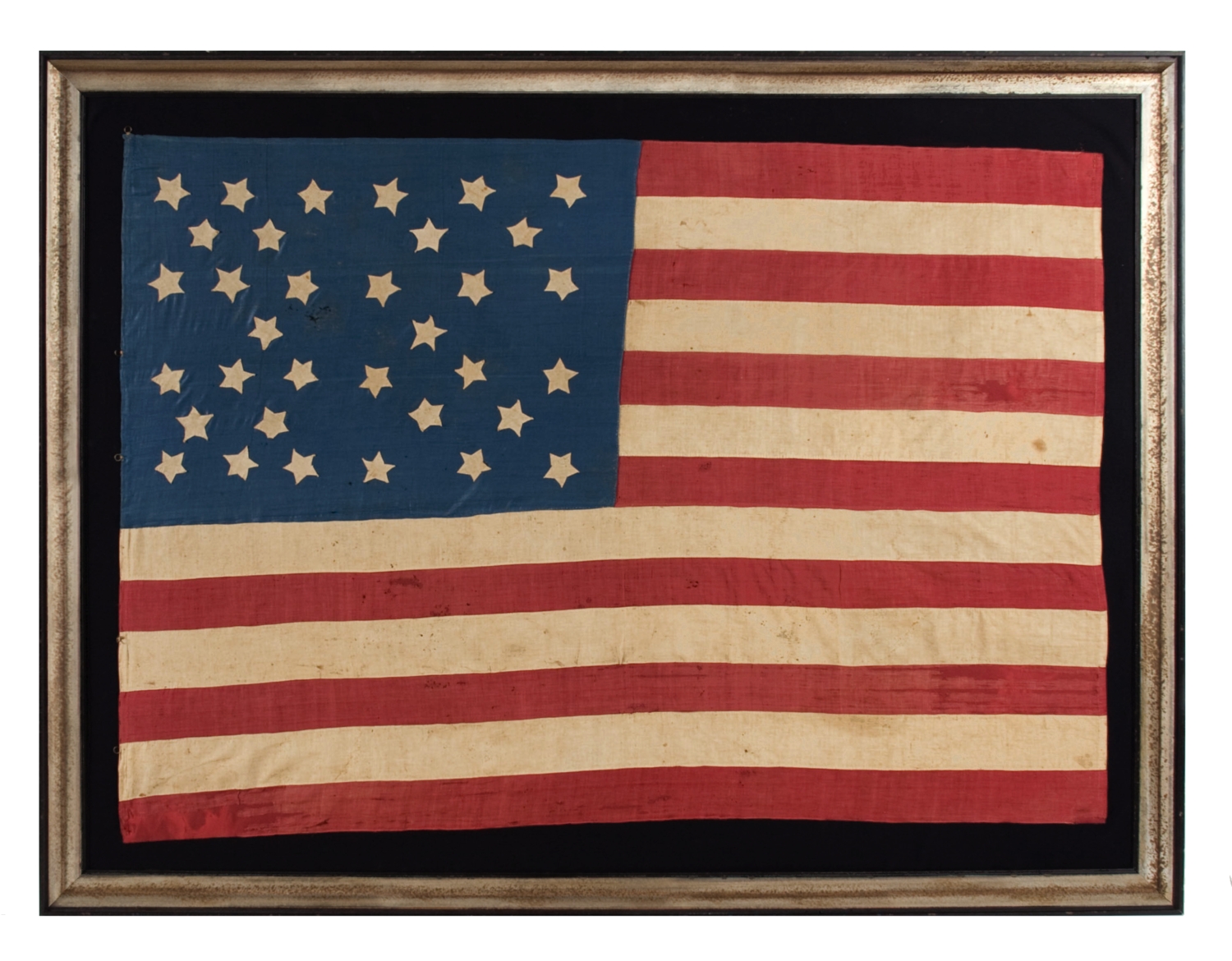
| |
34 STARS ON A HOMEMADE ANTIQUE AMERICAN FLAG OF THE CIVIL WAR ERA, WITH A CORNFLOWER BLUE CANTON AND A VERY INTERESTING CONFIGURATION THAT SUBTLY INCORPORATES THE CROSSES OF ST. ANDREW AND ST. GEORGE, REFLECTS KANSAS STATEHOOD, 1861-63 |
|
| Available: |
Sold |
| Frame Size (H x L): |
61" x 79.5" |
| Flag Size (H x L): |
48.75" x 68.5" |
|
| Description....: |
|
34 star American national flag, entirely hand-sewn and made of cotton. The stars are roughly arranged in seven staggered rows of 6-4-6-3-6-4-6. This is a particularly large number of rows for such a low star count, but it is far from the flag’s most intriguing feature. More significant is the secondary configuration that they subtly create, which includes both the crosses of St. Andrew and St. George, the primary features of the British Union flag. Note how it can be drawn from an elongated hexagon of 6 stars in the center, from which double, parallel rows of stars extend both perpendicularly and diagonally.
At this particularly patriotic point in American history, interesting messages of all sorts could appear in variations of the Stars & Stripes. At the onset of the war, Lincoln fervently urged the American people not to remove those stars from the flag that represented Southern States. His goal was to keep the nation together. Despite his pleas, some flag makers did as they chose, removing stars for states in the Confederate cause. Interestingly enough, the same was actually true in the South, both on variants of the first Confederate national flag, especially, and on adaptations of the American national flag to denote Southern sympathies. Here stars and/or stripes might be removed that represented the North.
At the same time that star and stripe counts were being manipulated, messages were also displayed in other ways. Sometimes the Southern Cross was incorporated into the star configuration of a traditional Stars & Stripes. It has been suggested by some flag historians--myself included--that Southern sympathy versions of the American national flag may have sometimes been flown to mark locations in the North, where Southerners might find refuge of some sort, i.e., a safe house or a place of business where southerners could expect to acquire supplies or obtain preferential treatment. The unusual thing about this particular flag is that by displaying both the Crosses of St. Andrew and St. George, British heritage might be claimed as then intended message, if anyone had a sharp enough eye to even notice the embedded pattern it in the first place.
Whatever the case may be regarding the maker's intent, this particular flag is a wonderful example of the Civil War period. Kansas was admitted into the Union as the 34th state on January 29th, 1861, about two-and-a-half months before the Confederate assault on Fort Sumter that marked the beginning of the Civil War. The 34th star was officially added on July 4th of that year, but most flag makers would have added a 34th star with the addition of Kansas, or potentially even prior to that time. The 34 star flag remained official until July 4th, 1863, and flags in this star count would have generally been produced until the addition of West Virginia on June 20th, just before the Battle of Gettysburg (July 1-3, 1863).
The stars of the flag are hand-sewn and double-appliquéd (applied to both sides). Note how their fat, starfish-like shape varies greatly from one to the next and how they point in various directions on their vertical axes. Also note how they are arranged on a canton that is unusual due to both its beautiful, cornflower blue color and the fact that it is of glazed cotton with a lustrous sheen. Glazed fabric is very desirable in early American textiles, but it isn’t often incorporated in early flags. In addition to the endearing presentation found in the accumulation of these features, they lend precisely the kind of charm that attracts both flag enthusiasts and Americana collectors to early examples of the Stars & Stripes.
Mounting: The flag was mounted and framed within our own conservation department, which is led by expert trained staff. We take great care in the mounting and preservation of flags and have framed thousands of examples. The background is 100% cotton twill, black in color, that has been washed and treated for color fastness. The black-painted, hand-gilded and distressed molding is Italian. The glazing is U.V. protective acrylic. Please inquire for further details.
Condition: There are minor to moderate tears and losses from obvious use throughout, the most significant of which are present near the fly end of the 3rd and 6th red stripes, as well as at and adjacent to the fly end in the last stripe. There is minor to modest faxing and staining, most notably in the white fabric, and there is minor fading of the red cotton. Many of my clients prefer early flags to show their age and history of use. |
|
|
|
| Collector Level: |
Advanced Collectors and the Person with Everything |
|
| Flag Type: |
Sewn flag |
|
| Star Count: |
34 |
|
| Earliest Date of Origin: |
1861 |
|
| Latest Date of Origin: |
1863 |
|
| State/Affiliation: |
Kansas |
|
| War Association: |
1861-1865 Civil War |
|
| Price: |
SOLD |
|
| |
Views: 906 |
|
|
|

